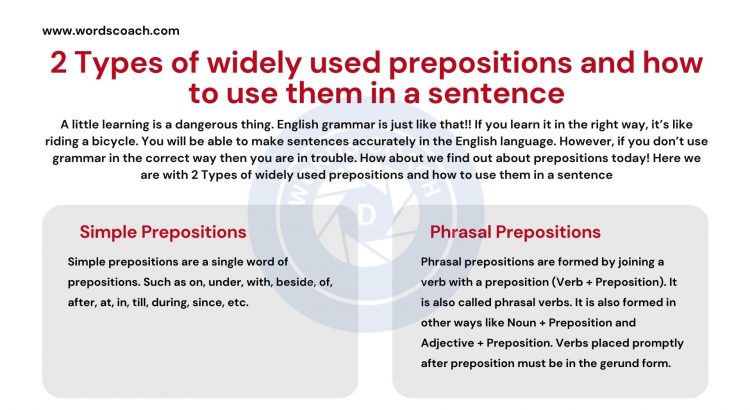2 Types of widely used prepositions and how to use them in a sentence
A little learning is a dangerous thing. English grammar is just like that!! If you learn it in the right way, it’s like riding a bicycle. You will be able to make sentences accurately in the English language. However, if you don’t use grammar in the correct way then you are in trouble. How about we find out about prepositions today! Here we are with 2 Types of widely used prepositions and how to use them in a sentence

What is a preposition?
A preposition is a word that shows the relationship between a noun and a pronoun or a noun and another noun or a pronoun and another pronoun. A preposition must have an object. It can be of one word, two-words, three-words, and four-words. Most commonly it can be classified into two types:
- Simple Prepositions
- Phrasal Prepositions
Let’s look at both of the types with examples.
1. Simple Prepositions:
Simple prepositions are a single word of prepositions. Such as on, under, with, beside, of, after, at, in, till, during, since, etc.
Here is a list of some commonly used prepositions:
| Prepositions | Examples |
| ON | John was born on 7th August 1997, in Delhi, the capital of India. |
| IN | The ball is in your court!! |
| UNDER | I’ve things under control. |
| AFTER | A dog is running after a monkey. |
| SINCE | Eric has been my best friend since my childhood. |
| BEHIND | The cat is hiding from the dog behind the wall. |
| DURING | I was bored during the lecture. |
| AT | Look at this beautiful flower, isn’t it wonderful? |
| OF | I am not fond of dancing. |
| FROM | She is from my town. |
| WITH | The lion was shot by Mary with a gun. |
| BESIDE | She sat beside me on the plane. |
| UPON | Place this mug upon the table. |
| ABOVE | Read the above passage and answer the following questions. |
| BY | The essay related to the economy was written by Carol with great perspicuity. |
| TO | Australia is to the South of India. |
| TILL | Please wait for me till 2 O’clock. |
| INTO | Police refused to look into the matter. |
| AMONG | Chocolates were distributed among the three brothers. |
| OFF | Monica fell off the horseback. |
2. Phrasal Prepositions:
Phrasal prepositions are formed by joining a verb with a preposition (Verb + Preposition). It is also called phrasal verbs. It is also formed in other ways like Noun + Preposition and Adjective + Preposition. Verbs placed promptly after preposition must be in the gerund form. Recognizing phrasal prepositions in a sentence is somewhat tricky as they don’t follow a certain pattern in terms of their position in a sentence. However, it becomes familiar when you get used to it.
For instance,
I apologize for my mistakes.
Hope for the best and prepare for the worst.
My parents are so proud of me.
Don’t do this for the love of God.
Jane is married to Jack.
I am aware of what’s going on in our city.
She is so careless about her future.
Sorry for the things I have done to you.
Always look for the bright side.
Why were you absent from class yesterday?
The Judge refused to give him bail.
Every citizen should abide by the laws of the country.
I don’t have access to use your computer.
I am familiar with all the concepts of physics.
We arrived at our holiday destination.
Jill is crazy about music.
Alex is good at sports.
Some key points to remember about prepositions:
- We are not supposed to use the prepositions at, in, on with the words last, next, every, this.
- There are prepositions like since, in, after, before can act both as a preposition and an adverb depending upon the sense they convey.
- Different and Separation are generally followed by the preposition from.
- Consider should not be used with the preposition.
- Regard is generally used as regard as a phrase in any sentence.
- There are some verbs that don’t take any prepositions. Such as concern, request, discuss, emphasize, demand, express, propose, lack.
- Need not, better, rather are the words which are not followed by the preposition to.
- While using some interrogative pronouns such as What, Whom, Where, Which, etc., we conventionally use the preposition at the start or at the end of the sentence.
In the day-to-day speech, we fall into some negative behavior patterns, using prepositions where they are a bit much. It would be a smart thought to eliminate these words, however, we should be particularly mindful so as not to utilize them in formal, academic prose. Processing the knowledge of where not to use prepositions is something you acquire with habitual reading.
Hope it helps!! Happy Learning
Written by,
Jaini Bhavsar (There’s always room for bliss.)
28th May 2020
Connect with me on LinkedIn
Download the Word Coach Application
FAQ’s
What are the two types of prepositions you are focusing on?
As you haven’t specified the two types, I can’t answer this precisely. Please tell me which prepositions you’d like to explain, and I’ll gladly create FAQs accordingly!
Where can I find more information about prepositions?
Many resources are available! Online grammar guides, dictionaries, and textbooks can offer detailed explanations and examples. I can also provide you with additional resources if you’d like.
I’m interested in “in” and “on.” Are these good examples?
Yes, “in” and “on” are excellent choices! They are both common prepositions with numerous applications, making them perfect choices for an educational resource.

